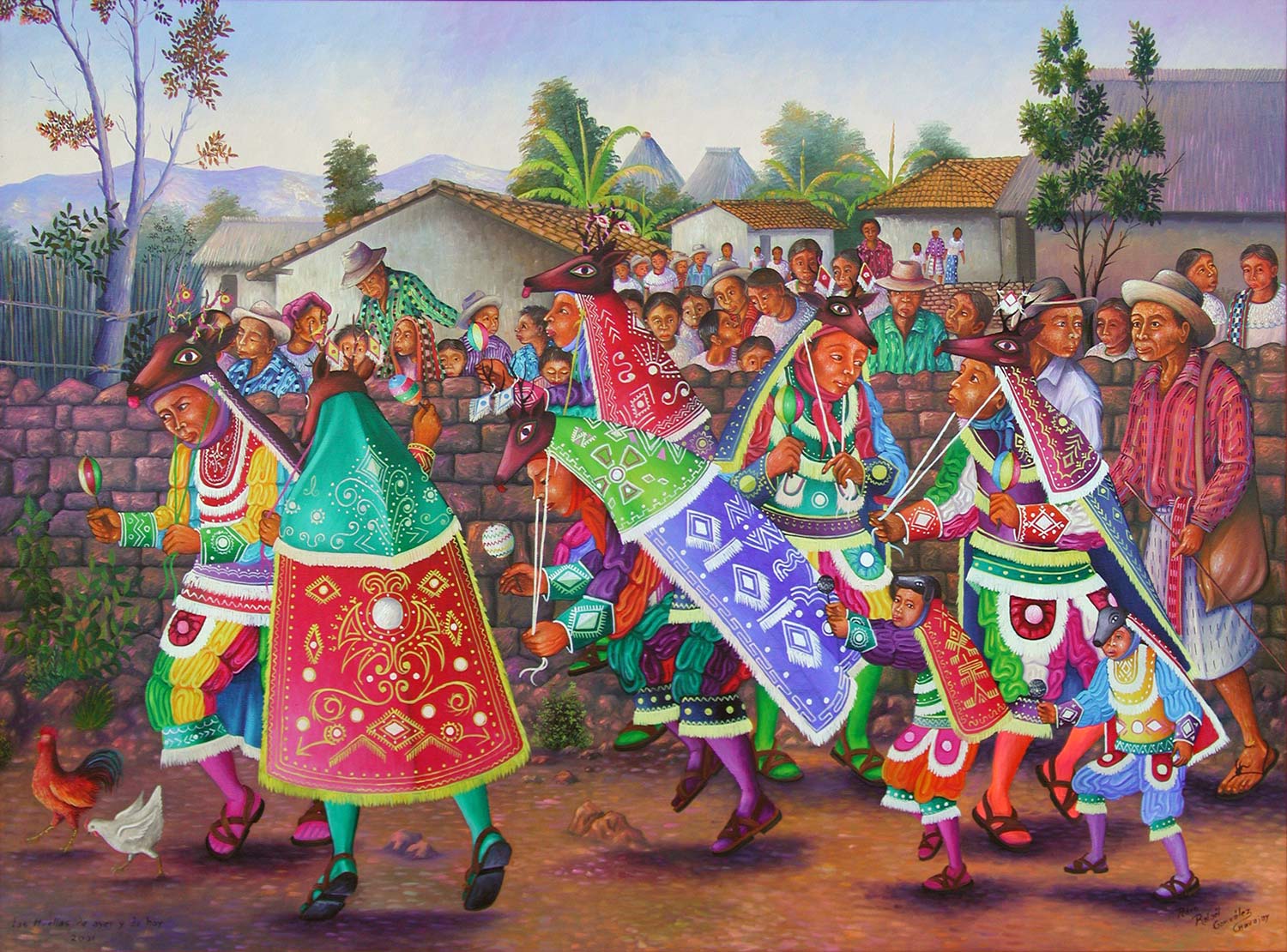Panel 1: Pre-Hispanic Traditions
The left panel of the triptych shows dancers dressed as deer heading the procession. Pedro Rafaél, realizing the visual importance of the dancers to the painting, has allowed the other dancers, dressed as tigers and monkeys, as well as the musician playing the marimba, to straggle over into the first half of the second panel. This is artistic license and does not really detract from his concept of the triptych showing the fracturing of Maya society.
The dance depicted is the Baile de Venado, or Deer Dance, but it could just as easily have been one of the other popular masked dances such as the Dance of the Conquest, the Dance of the Moors and the Christians, or the Little Bull. The Baile de Venado is one of the oldest of the dances and has pre-Hispanic roots.
After the arrival of the Europeans, many dances were forbidden by the Catholic Church because they were deemed heathen. The dances that did survive had to conform in some way. Performing the Deer Dance for the day of the patron saint of the town, and dedicating the captured deer to Jesus, made the dance nominally Christian. It allowed some ancient Maya beliefs and traditions to survive, somewhat adjusted, under the cloak of Christianity. In other towns, the text of the Baile de Venado is different. In Tz’utujil towns such as Santiago Atitlán and San Pedro, it is a story of the hunt, or the myth of creation or birth.
The effort that the person makes to participate in the dance signifies the reunion with life and nature. This effort involves great expense to rent all the masks and costumes, the maintenance of the family during the time that the whole process lasts, and the performance of the dance. Thus this effort also has its time before and after, for the group of dancers and the family of each of the participants.
Because of the effort and expense, especially in the smaller towns, the masked dances usually are only performed during the festival of the town’s patron saint. The most elaborate and expensive of the dances is the Baile de Conquista (Dance of the Conquest), so in smaller towns, which San Pedro was at the time, the Deer Dance was a popular alternative. Preparation for the dance began many months before the feria titular (town festival). The person responsible to produce the dance was the director, someone knowledgeable about the contents and steps of the dance. The director was responsible for choosing which dance will be performed, who the dancers will be, and for gaining support and funding among the townspeople.
The rehearsals were held at the director’s house, or at the house of a particular cofradía. This involved considerable expense, as food and beverages must be provided for the dancers. The town would hire a dance master, although sometimes the director and dance master might be the same person. The dance master would thoroughly know the dance so that he could teach the performers their roles and their lines. For this the dance master had to know how to read and write. He was owner and guardian of the script, which was used to teach their lines to each of the dancers, most of whom were illiterate. The dance master also taught them the dance steps that go with each of their songs. Because the dance master was paid for his services, he carefully guarded his manuscript. A dance master would probably train a son to inherit his position and pass on his manuscript to him. For a complicated dance like the Baile de Conquista, the dance master might come from another town, and serve as the dance master of this dance in several communities (Bode 1961).
The masks and costumes are rented from a morería, an establishment peculiar to Guatemala. It is usually run by a family of talented mask-makers who pass down the business from generation to generation. When the time of the festival is approaching, the dance master and all of the members of the dance troupe travel to the morería to rent the costumes. Before the Pan American highway was constructed, this meant a walk of about two days each way to the town of Totonicapán, the nearest morería to San Pedro la Laguna. As shown in the painting, the deer, in costumes rented from the morería, wear fanciful versions of the elaborate capes worn by the Spanish. These flashy costumes are often satin and decorated with sequins and bits of mirror. Undoubtedly, the ancient Maya dressed in the skins of deer for the dance. While dancers in some towns still wear deer skins, the dancers and spectators seem to prefer the costumes rented from the morerías. This is not surprising because the isolation of Maya towns meant the dances were the highlight of the year (Luján Muñoz 1987).
One of the very important events for the organizer and the group of dancers, is to ask permission for the beginning of the organization of the production. This may occur once or twice before the performance. The dance group would go to a sacred place in the mountains, generally a cave, and the person in charge of the offering is an Ajq’iij or spiritual guide who would perform a blessing so that the production could start and finish well. During the ritual they would call on the four cardinal points, burning colored candles and incense, while offering sugar, cakes, and chocolate to the spirits of the earth, sky, and lake. Upon their return from the morería with their costumes, a last ritual would be performed in the mountains with much ritual drinking to induce a trance.


